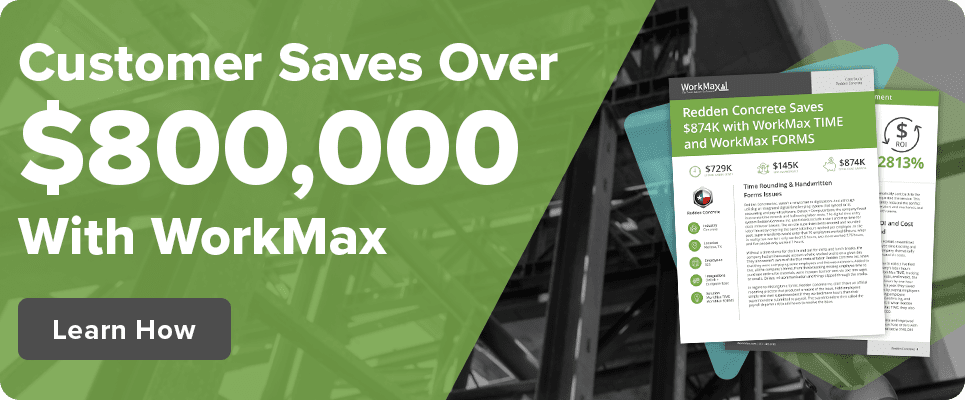Our users reported over 96% customer satisfaction for the last 10 years. Schedule a personal tour of our software to see how we can improve your business’s productivity.
Table of Contents
Share Article
Construction time tracking is uniquely challenging because crews are working across multiple projects and locations simultaneously. Attempting to manually track time under these circumstances is nearly impossible. It’s also hard to identify and follow-up with inconsistencies, making time theft much easier.
Let’s break down why manual time tracking doesn’t cut it anymore, and how switching to a digital time tracking app can reduce unnecessary costs.

Key Takeaways
- Manual time tracking opens the door for time theft and inflated labor costs.
- Contractors who rely on manual time tracking have more administrative burden than those who invest in construction time tracking software.
- Construction time tracking apps — like WorkMax — automate time tracking, simplify compliance and gives contractors more time to focus on growing their business.
The Problems with Manual Time Tracking
Manual time tracking opens the door to several challenges that can derail projects and erode profits. Let’s discuss the shortcomings of manual time tracking to determine how it can be affecting your business and how to address these concerns.
1. Inaccuracies and Time Theft
Paper timesheets rely entirely on honesty and memory. Workers may clock in or out at any given time or fill out timesheets at the end of the day (or worse — at the end of the week), leading to guesswork and rounding errors. There’s also the risk of buddy punching — when one employee clocks in or out for another. According to Hubstaff, 43% of workers admit to committing time theft.
In an industry where labor is one of your biggest costs, even small inaccuracies can snowball into massive financial waste.
2. Delays in Data Collection
Manual processes mean waiting. Waiting for foremen to collect timesheets. Waiting for office staff to enter data. Waiting to run payroll and see the impact of labor costs.
By the time the information reaches decision-makers, it’s often already outdated. That delay limits your ability to make informed project decisions in real time.
3. Administrative Burden
Manual time tracking eats up valuable hours from field and office teams. Supervisors spend time chasing down missing timesheets. Administrative staff manually calculate hours. Mistakes are common — and correcting them wastes even more time.
This administrative drag takes focus and energy away from higher-value work that actually moves projects forward.
4. Compliance Risks
Labor laws and regulations are complex and ever-changing. Oftentimes, manual time tracking has a hard time accurately accounting for overtime and breaks, opening your company up to audits, penalties or other legal action.
Without detailed, real-time digital records, it’s difficult to prove compliance.
Why Accurate Data Matters More Than Ever

The construction market today is under immense pressure — from tariffs to shifting immigration policies, project delays and tight timelines.
In this climate, operational efficiency isn’t just nice to have it. It’s a competitive advantage that can help your company thrive.
Let’s explore how digital time tracking works and the benefits of construction time tracking apps.
The Benefits of Digital Time Tracking
Digital time tracking apps designed for construction teams are not just a trend — they’re becoming the industry standard. Here’s why.
1. Real-Time Visibility
Digital apps allow crew members to clock in and out from their phones — often with GPS tagging to confirm location. Supervisors can see who’s working onsite or on break in real time. This visibility empowers contractors to make faster, more informed decisions throughout a project’s lifecycle.
2. Improved Accuracy
Time entries are captured in real-time. Many construction time tracking apps support facial recognition or geofencing to eliminate buddy punching and ensure accountability. That means more accurate payroll and less unnecessary labor costs.
3. Easily Maintain Compliance
With digital records, you get detailed logs of hours worked, breaks and overtime — all securely stored and easily accessible. That makes it easier to stay compliant with labor laws and union rules, and to recall time tracking data if you’re ever audited.
4. More Time to Drive Success
By reducing tedious administrative work, your teams can focus on higher-value activities — like:
- Managing the job site
- Solving project challenges
- Growing your business
By streamlining administrative tasks, you’re not just saving time — you’re empowering your teams to focus on more important tasks that require their attention. The result is a more efficient operation, better project outcomes and a business that’s built to scale.
Automate Your Time Tracking With WorkMax
Manual time tracking might have worked in the past, but in today’s construction environment, it’s not just outdated — it’s a liability. By leveraging construction time tracking apps — like WorkMax — you can automate your time tracking to save time, reduce disputes and avoid inflated labor costs.
WorkMax offers:
- Precise digital time tracking
- Patented facial recognition technology
- Digital time approvals to reduce disputes
- Integration with leading payroll services and accounting software
With WorkMax, contractors can make their time tracking process stress-free while being able to focus more time and energy on driving project success and growing their businesses.
For more information about WorkMax, talk to a specialist.
